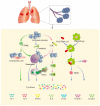Crosstalk between Inflammation and Hemorrhage/Coagulation Disorders in Primary Blast Lung Injury
- PMID: 36830720
- PMCID: PMC9953683
- DOI: 10.3390/biom13020351
Crosstalk between Inflammation and Hemorrhage/Coagulation Disorders in Primary Blast Lung Injury
Abstract
Primary blast lung injury (PBLI), caused by exposure to high-intensity pressure waves from explosions in war, terrorist attacks, industrial production, and life explosions, is associated with pulmonary parenchymal tissue injury and severe ventilation insufficiency. PBLI patients, characterized by diffused intra-alveolar destruction, including hemorrhage and inflammation, might deteriorate into acute respiratory distress syndrome (ARDS) with high mortality. However, due to the absence of guidelines about PBLI, emergency doctors and rescue teams treating PBLI patients rely on experience. The goal of this review is to summarize the mechanisms of PBLI and their cross-linkages, exploring potential diagnostic and therapeutic targets of PBLI. We summarize the pathophysiological performance and pharmacotherapy principles of PBLI. In particular, we emphasize the crosstalk between hemorrhage and inflammation, as well as coagulation, and we propose early control of hemorrhage as the main treatment of PBLI. We also summarize several available therapy methods, including some novel internal hemostatic nanoparticles to prevent the vicious circle of inflammation and coagulation disorders. We hope that this review can provide information about the mechanisms, diagnosis, and treatment of PBLI for all interested investigators.
Keywords: acute lung injury; blast injuries; blood coagulation; hemorrhage; inflammation; therapeutics.
Conflict of interest statement
The authors declare no conflict of interest.
Figures



Similar articles
-
Computational Modeling of Primary Blast Lung Injury: Implications for Ventilator Management.Mil Med. 2019 Mar 1;184(Suppl 1):273-281. doi: 10.1093/milmed/usy305. Mil Med. 2019. PMID: 30901433 Free PMC article.
-
Primary blast lung injury at a NATO Role 3 hospital.J R Army Med Corps. 2014 Jun;160(2):161-6. doi: 10.1136/jramc-2013-000216. Epub 2014 Jan 24. J R Army Med Corps. 2014. PMID: 24464466
-
Damage-Associated Molecular Patterns and Their Signaling Pathways in Primary Blast Lung Injury: New Research Progress and Future Directions.Int J Mol Sci. 2020 Aug 31;21(17):6303. doi: 10.3390/ijms21176303. Int J Mol Sci. 2020. PMID: 32878118 Free PMC article. Review.
-
Pre-hospital continuous positive airway pressure after blast lung injury and hypovolaemic shock: a modelling study.Br J Anaesth. 2022 Feb;128(2):e151-e157. doi: 10.1016/j.bja.2021.10.012. Epub 2021 Dec 2. Br J Anaesth. 2022. PMID: 34863511
-
[Advances in the research of blast lung injury].Zhonghua Shao Shang Za Zhi. 2016 Mar;32(3):156-9. doi: 10.3760/cma.j.issn.1009-2587.2016.03.007. Zhonghua Shao Shang Za Zhi. 2016. PMID: 27030652 Review. Chinese.
Cited by
-
Impact of acute stress disorder on surfactant protein D levels in acute lung injury.J Mol Histol. 2024 Oct;55(5):793-801. doi: 10.1007/s10735-024-10231-3. Epub 2024 Aug 7. J Mol Histol. 2024. PMID: 39110365
-
Evaluating the effectiveness of handheld ultrasound in primary blast lung injury: a comprehensive study.Sci Rep. 2025 Jan 18;15(1):2358. doi: 10.1038/s41598-025-86928-6. Sci Rep. 2025. PMID: 39824921 Free PMC article.
-
Pathophysiological changes and injury markers for acute lung injury from blunt impact in infant rabbits.Front Pediatr. 2024 Jun 7;12:1354531. doi: 10.3389/fped.2024.1354531. eCollection 2024. Front Pediatr. 2024. PMID: 38910959 Free PMC article.
-
Elevated international normalized ratio contributes to poor prognosis in patients with traumatic lung injury.Front Med (Lausanne). 2024 Aug 2;11:1426999. doi: 10.3389/fmed.2024.1426999. eCollection 2024. Front Med (Lausanne). 2024. PMID: 39156692 Free PMC article.
References
Publication types
MeSH terms
Grants and funding
- TJUWYY2022002/The Scientific Research Translational Foundation of Wenzhou Safety (Emergency) Institute of Tianjin University
- BLB19J006/the Key Project of Applied Basic Research of the Logistics Support Department of the Chinese People's Liberation Army
- 32000877/National Natural Science Foundation of China
LinkOut - more resources
Full Text Sources
Medical
Research Materials

